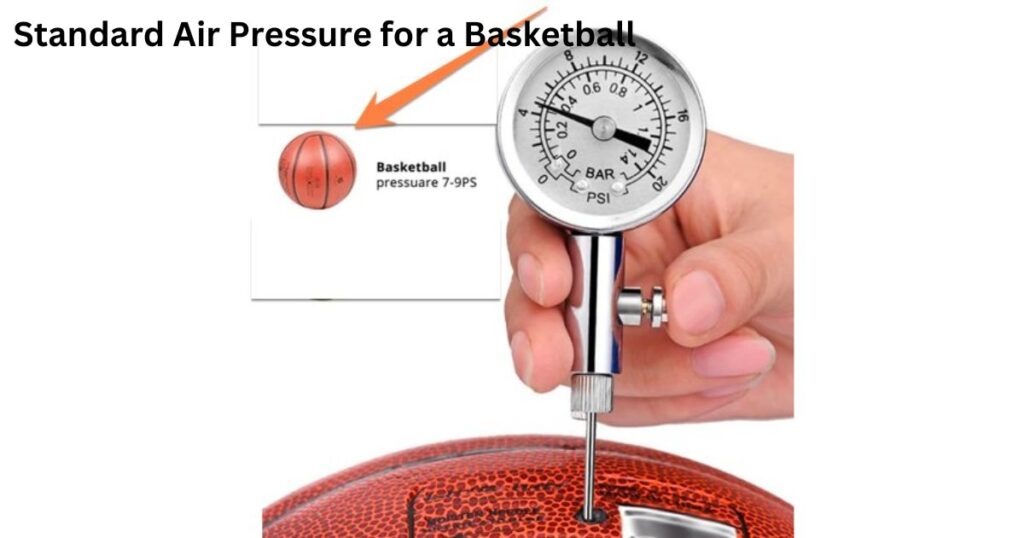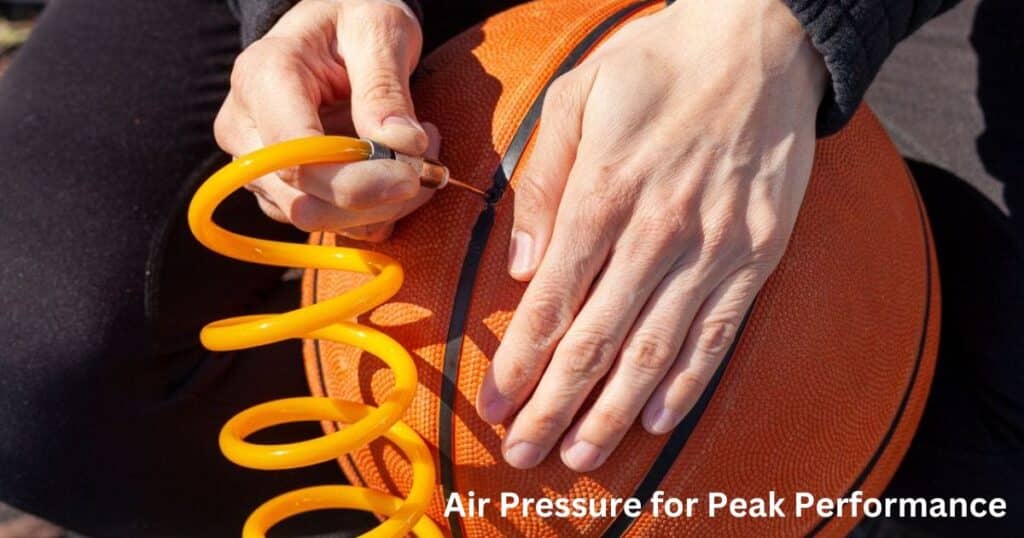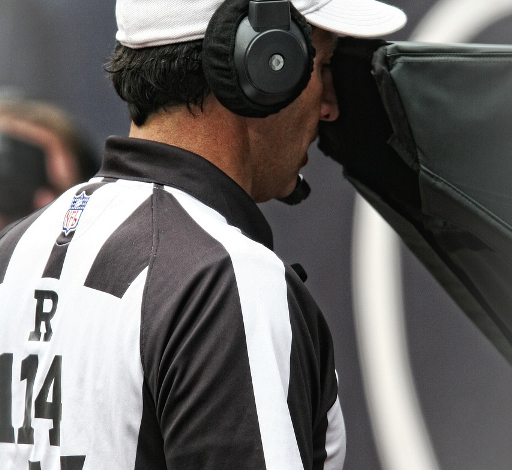
You ever picked up a basketball that just felt “off”? Like it wouldn’t quite bounce right or felt too squishy in your hands? Chances are, the air pressure was whack.
Air pressure is the secret sauce that gives a basketball its life and responsiveness on the court. Get it dialed in just right, and you’ll unlock a whole new level of gameplay.
We’re talking controlled dribbles, feathery-soft shooters’ touches, and consistent bounces you can set your watch to. But get that PSI out of whack? Well, get ready for some serious frustration and sloppy play.
Bottom line – air pressure might seem like a small detail, but it’s a crucial piece of the puzzle for ballers looking to bring their A-game. Let’s dive into unlocking that sweet spot and leaving those air pressure woes behind.
What is Air Pressure in Basketball?
Plain and simple, air pressure is what gives a basketball its bounce and liveliness. It’s that perfectly inflated sweet spot that makes the ball feel right in your hands.
Too much air? Rock-solid and unforgiving. Too little? Floppy and unpredictable. But get that air pressure just right? Game on.
The ball moves with precision, allowing you to dribble with control and shoot with accuracy.
Why is Air Pressure Important in Basketball?
Sure, you could play with any old ball. But why settle for a frustrating experience? Proper air pressure is the key to unlocking a basketball’s true potential on the court.
With the right PSI (pounds per square inch), your dribbles have that consistent bounce.
No erratic skips or splats that throw off your rhythm. Just a smooth, steady cadence to keep you in the zone.
And those shots? They’ll feel weightless leaving your fingertips with the perfect inflation.
No fighting against the ball’s resistance or watching it sail long from being too firm. But it’s not just about your individual game.
The right air pressure ensures a level playing field for both teams. No unfair advantages or disadvantages from using an improperly inflated ball. Simply put, air pressure is what separates a quality basketball experience from a sloppy, frustrating one.
What is the Standard Air Pressure for a Basketball?

You can’t just go pumping air into a ball all willy-nilly. There are recommended PSI ranges to follow based on the league and level of play.
For the NBA’s official game ball, we’re talking 7.5 to 8.5 PSI. The women’s ball used in the NCAA and FIBA sits a tad lower at 6.5 to 8.5 PSI. These aren’t just random numbers, folks. They’re carefully tested and approved by the governing bodies to optimize performance.
But here’s the kicker – those ranges leave a little wiggle room for personal preference.
Some players might like their ball on the firmer end of the spectrum for extra spring off the dribble. Others may want a softer feel for a buttery shooting touch.
No two ball handlers are exactly alike. The key is finding that Goldilocks zone where the air pressure feels just right for you.
How to Check and Adjust Air Pressure in a Basketball?
Alright, so you’ve got aball that’s either overinflated or underinflated. Now what? No need for fancy equipment – a few basic tools and a little technique is all you need. First thing’s first, grab yourself a pressure gauge (every baller should have one).
These nifty devices let you check the existing PSI with a simple needle insertion into the ball’s air valve. If the reading falls outside of that recommended range, it’s time to make an adjustment.
That’s where a good ol’ ball pump (or even a bike pump in a pinch) comes in handy. For an underinflated ball, it’s as easy as giving it a few extra squeezes to get that air pressure up.
Just be careful not to overdo it – you don’t want to create a rock.
If your gauge is showing too much PSI, simply press down on the needle to release some of that excess air. Little by little until you hit your sweet spot.
Pro Tip: Always inflate your ball in small bursts and check the pressure frequently. It’s easier to add more air than release too much.
But what if you don’t have a pressure gauge on hand? No sweat, there are a couple simple tricks:
The Feel Test: Give that ball a firm squeeze. It should have a little give, but not feel like a balloon about to pop.
The Bounce Test: Hold the ball at chest height and let ‘er drop. On perfect inflation, it should bounce back up to about hip level. Too high or low? You know what to do.
Read More: Understanding Hand Checking in Basketball: A Guide to the Rule, Impact, and Debates
Maintaining Air Pressure for Peak Performance

Hitting that sweet spot for air pressure is only half the battle. You’ve got to maintain those perfect PSI levels for consistent gameplay.
The very act of dribbling, shooting, and generally putting that ball through its paces causes slow air leakage over time.
Not to mention, extreme temperatures can cause the air to expand or contract. That’s why it’s smart to check your basketball’s pressure before every game or practice session.
A quick once-over can reveal whether you need to make any minor adjustments. It’s also crucial to invest in a quality ball made for serious play.
Those cheap-o rubber bladders just can’t hold air pressure like a legit composite leather interior can. When you’re not using your prized possession, proper storage is a must.
A cool, dry place is ideal to prevent any funky fluctuations. And a breathable mesh bag beats holding it captive in an airtight container.
Bonus Insights on Air Pressure from the Pros
You didn’t think we’d leave you hanging without some insider tips from the big ballers, did you?
We caught up with a few veterans of the game to get their personal takes on air pressure’s impact:
“I like to keep my balls on the firmer side of the spectrum,” revealed All-Star PG Kyle Anderson. “That extra responsiveness off the dribble gives me an edge for getting by defenders.”
But his teammate, sharpshooter Ashley Brooks, had a different stance: “I actually prefer mine a little underinflated. That softer feel helps me get a real pure shooter’s touch on my jumpers.”
Even at the highest levels of the game, air pressure comes down to feel and personal preference.
As Hall-of-Famer Alicia Santiago put it: “Finding that perfect PSI sweet spot for you is like getting fitted for a custom suit. It just fits right.”
It’s about dialing in what works best for your unique playing style and sticking within those recommended league ranges. So don’t be afraid to experiment until you find that Goldilocks inflation that has you playing your best ball.
Read Also: What is the Bonus in Basketball?
Getting Your Air Pressure Dialed In
At the end of the day (or game), air pressure is one of those under-appreciated details that can make or break your hoop experience.
But now you’re armed with the knowledge to make sure your balls are always properly inflated and primed to perform.
From understanding why those PSI levels matter to the simple techniques for checking and adjusting air pressure, you’ve got this on lock.
So grab that gauge, pump, and favorite ball, and dial in your personal sweet spot. A little air pressure mastery goes a long way towards leveling up your game.
Your shots will feel truer, your handles will be crisper, and your overall court experience will just feel… perfect.
After all, the tiny difference between a ball that’s “meh” and one that’s “money” often comes down to just a few extra pumps (or squeezes). So next time you hit the court, don’t overlook this crucial factor.
Give your game the freedom to shine by playing with that perfectly inflated ball. Trust us, you’ll feel the difference. And your teammates will see it.
The Science Behind Air Pressure and Ball Performance

You know what they say – math doesn’t lie! There’s some serious science behind why proper air pressure translates to optimal ball performance. It all comes down to the fundamental laws of physics governing acceleration, velocity, and energy transfer.
An overinflated basketball has very little give when it strikes a surface. That firmness causes more energy to be transferred back into the ball instead of being absorbed. The result? An erratic, difficult to control bounce.
Too little air pressure creates the opposite problem. The ball deforms significantly on impact, absorbing more energy and losing velocity faster. You’re left with a ball that doesn’t quite have enough oomph to go the distance. But that perfectly inflated sweet spot? Chef’s kiss.
Just the right amount of deformation allows the ball to ride out that impact energy and maintain an ideal trajectory. Cue the smooth, predictable bounces that make executing precise dribble moves a breeze.
Air pressure is everything when it comes to getting the most outta your basketball. Too much or too little can totally throw off your game. But hit that sweet spot? Money.
We’re talking the difference between bricks and swishes, between losing control on dribble moves and handling like a pro. The right PSI lets you unlock a ball’s true potential for consistent bounces and pure shooting strokes.
From why air pressure matters to checking and adjusting it, this guide covers all the deets. You’ll learn the standard ranges, simple hacks for dialing it in, and even insights from the pros themselves.
Master this crucial factor and you’ll be ballin’ out with precision and control every time you hit the court. Don’t sleep on air pressure – it’s a game-changer.
Read Also: How Tall is a Basketball Hoop
Air Pressure Hacks for the Busy Baller
Look, we get it – you’ve got games to win, not hours to spend fiddling with tire gauges. Here are some clutch air pressure hacks to save you time:
Portable Pressure Gauge
Invest in one of those keychain pressure gauges so you can quickly check PSI courtside. No more running back to your bag between games.
Multi-Ball Rotation
Have two or three game balls in your rotation and check them all pre-game. That way you’ve always got a properly inflated backup ready to sub in when needed.
The “Hot Potato” Trick
No gauge? No problem. Rapidly rotate the ball between your hands for 15-20 seconds. An underinflated ball will get “bigger” while an overinflated one will feel “smaller” from the heat expansion.
Leave It In The Ball Bag
When traveling, keep your balls safely inflated by leaving them in your mesh ball bag instead of an airtight duffle where pressure can fluctuate.
Mark Your “Sweet Spot”
Once you’ve found that perfect personal PSI, use a ballpoint pen to mark your sweet spot on the pump gauge. Remove all guesswork for fast re-inflating.
With a few simple tips and habit tweaks, achieving optimal air pressure is a snap. No more making excuses for sub-par performance!
FAQ’s
How much air pressure goes in a basketball?
NBA game balls use 7.5 to 8.5 PSI. Women’s NCAA/FIBA balls use 6.5 to 8.5 PSI. The right PSI range ensures optimal performance.
Does air pressure affect the bounce of a basketball?
Yes, it does. Too much air makes it bouncy and hard to control. Too little air makes it deadened with poor bounces. The sweet spot gives a consistent, responsive bounce.
Why is air pressure important in balls?
It impacts control, accuracy, and performance. Proper pressure lets you dribble smoothly, shoot with touch, and get reliable bounces. It unlocks the ball’s true potential.
How do you know if a basketball is inflated properly?
Use a pressure gauge for the precise PSI reading. Or do the squeeze test – it should have a little give but be firm. Or the bounce test – it should return around hip height.
Final Words
Air pressure is everything when it comes to getting the most outta your basketball. Too much or too little can totally throw off your game. But hit that sweet spot? Money.
We’re talking the difference between bricks and swishes, between losing control on dribble moves and handling like a pro. The right PSI lets you unlock a ball’s true potential for consistent bounces and pure shooting strokes.
From why air pressure matters to checking and adjusting it, this guide covers all the deets. You’ll learn the standard ranges, simple hacks for dialing it in, and even insights from the pros themselves.
Master this crucial factor and you’ll be ballin’ out with precision and control every time you hit the court. Don’t sleep on air pressure – it’s a game-changer.



